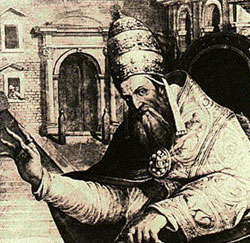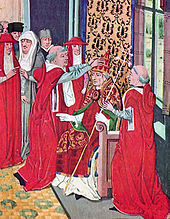
Pope Gregory XI Born Pierre Roger de Beaufort in 1329, Pope Gregory XI was the last Frenchman elected to the papacy and was the first pope to reside in Rome after popes had ruled from Avignon for 68 years. He began his career early: at 11, he was made canon of Rodez and Paris, and at 19, he was made a cardinal deacon by his uncle, Pope Clement VI. Gregory was ordained a priest after his election to the papal throne in 1370. Both St. Bridget of Sweden and St. Catherine of Siena urged Gregory to return to Rome. He entered the city in January of 1377, but he left again after a massacre led by his legate, Robert of Geneva (later Antipope Clement VII), at Cesena a month later. Gregory died of exhaustion in March, 1378.
Pope from 1370 to 1378
Pope Gregory XI (Latin: Gregorius, born Pierre Roger de Beaufort; c. 1329 – 27 March 1378) was head of the Catholic Church from 30 December 1370 to his death in 1378. He was the seventh and last Avignon pope and the most recent French pope recognized by the modern Catholic Church. In 1377, Gregory XI returned the Papal court to Rome, ending nearly 70 years of papal residency in Avignon, France. His death shortly after was followed by the Western Schism involving two Avignon-based antipopes.
Early life
Pierre Roger de Beaufort was born at Maumont, France, around 1330. His uncle, Pierre Cardinal Roger, Archbishop of Rouen, was elected pope in 1342 and took the name Clement VI. Clement VI bestowed a number of benefices upon his nephew and in 1348, created the eighteen-year-old a cardinal deacon. The young cardinal attended the University of Perugia, where he became a skilled canonist and theologian. He later held the position of protodeacon of the Sacred College.
Conclave 1370
Main article: 1370 papal conclave Coronation of Gregory XI
Coronation of Gregory XI
After the death of Pope Urban V (December 1370), eighteen cardinals assembled at Avignon entered the conclave on 29 December. Cardinal Roger was unanimously elected on 30 December. Though initially opposing his own election, Roger eventually accepted and took the name of Gregory XI. On 4 January 1371 he was ordained to the priesthood by the Dean of the College of Cardinals, Guy de Boulogne, and on 5 January was consecrated Bishop of Rome and crowned by the new protodeacon Rinaldo Orsini in the cathedral Notre Dame des Doms in Avignon.
Papacy
Immediately on his accession he attempted to reconcile the Kings of France and England, but failed. Gregory confirmed a treaty between Sicily and Naples at Villeneuve-lès-Avignon on 20 August 1372, which brought about a permanent settlement between the rival kingdoms, which were both papal fiefs.
Johannes Klenkok's Decadicon, that he wrote against the Sachsenspiegel law-book was submitted to Pope Gregory XI in the early part of the 1370s by French canonist and cardinal of the Curia Pierre de la Vergne. Gregory formally condemned fourteen articles of the Sachsenspiegel in the papal bull Salvator Humani Generis in 1374 and nineteen propositions of John Wycliffe's On Civil Dominion in 1377. and 21 proposed reformation articles of Johannes Klenkok's Decadicon
He also made efforts towards the reunion of the Greek and Latin Churches, the undertaking of a crusade, and the reform of the clergy. Efforts were made to reform corrupt practices in the various monastic orders, such as collecting fees from persons visiting holy sites and the exhibiting of faux relics of saints. In 1373 he approved the Order of the Spanish Hermits of St. Jerome.
Soon, however, he had to give his entire attention to the turbulent affairs of Italy. Duke Bernabo Visconti of Milan, had, in 1371, made himself master of Reggio and other places that were feudatory to the Holy See. Gregory XI excommunicated him. Bernabo compelled the legates that brought him the Bull of excommunication to eat the parchment on which his excommunication was written. Hereupon Gregory XI declared war upon him in 1372. Success was at first on the side of Bernabo, but when Gregory XI obtained the support of the emperor, the Queen of Naples, and the King of Hungary, Bernabo sued for peace. By bribing some of the papal councillors he obtained a favourable truce on 6 June 1374.
Like the preceding popes of Avignon, Gregory XI made the fatal mistake of appointing Frenchmen, who did not understand the Italians and whom the Italians hated, as legates and governors of the ecclesiastical provinces in Italy. The Florentines, however, feared that a strengthening of the papal power in Italy would impair their own prestige in Central Italy and allied themselves with Bernabo in July 1375. Both Bernabo and the Florentines did their utmost to stir up an insurrection in the pontifical territory among all those that were dissatisfied with the papal legates in Italy. They were so successful that within a short time the entire Patrimony of St. Peter was up in arms against the pope. Highly incensed at the seditious proceedings of the Florentines, in 1376, Gregory XI put Florence under interdict, excommunicated its inhabitants, and outlawed them and their possessions. They sent St. Catherine of Siena to intercede for them with Gregory XI, but frustrated her efforts by continuing their hostilities against the pope.
Return to Rome
 A bolognino of Gregory XI
A bolognino of Gregory XI
Gregory XI's decision to return to Rome has been attributed in part to the incessant pleas, demands, and threats of Catherine of Siena. Gregory's predecessor, Urban V, had tried to return as well, but the demands of the Hundred Years' War brought him north of the Alps again, and Avignon was still the seat of the bishop of Rome.
The return of the Curia to Rome began on 13 September 1376. Despite the protests of the French king and the majority of the cardinals, Gregory left Avignon on that day and made his way to Marseilles, where he boarded a ship on 2 October. Arriving at Corneto on 6 December, he decided to remain there until arrangements were made in Rome concerning its future government. On 13 January 1377, he left Corneto, landed at Ostia the next day, and from there sailed up the Tiber to the monastery of San Paolo. On 17 January he left the monastery to make a solemn entrance into Rome that same day.
But his return to Rome did not put an end to hostilities. The massacre at Cesena, which was ordered by Cardinal Robert of Geneva, embittered the Italians still more against the pope. Continuing riots induced Gregory to remove to Anagni towards the end of May 1377. He gradually quelled the commotion himself and went back to Rome on 7 November 1377, where he died while a congress of peace was in process at Sarzano.
Gregory XI was the last pope of French nationality. He was learned and pious, though not free from nepotism. As the situation in Rome was getting worse, his death prevented him from returning to Avignon.
Death
Gregory XI did not long survive this trip, dying in Rome on 27 March 1378. He was buried the following day in the church of Santa Maria Nuova. After his death the College of Cardinals was pressured by a Roman mob that broke into the voting chamber to force an Italian into the papacy. The Italians chose Urban VI. Soon after being elected, Urban gained the cardinals' enmity. The cardinals withdrew from Rome to Fondi, where they annulled their election of Urban and elected a French pope, Clement VII, before returning to Avignon in 1378.
Subsequently, the Western Schism created by the selection of rival popes forced Europe into a dilemma of papal allegiance. This schism was not resolved fully until the Council of Constance (1414–1418).





